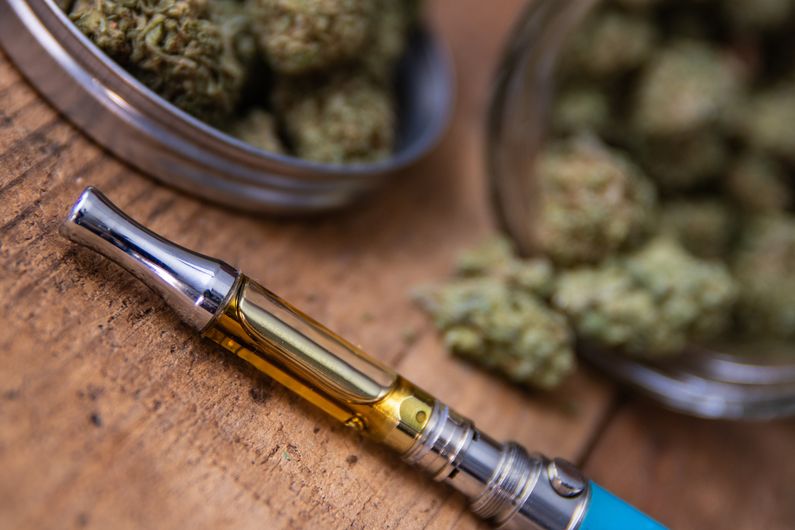A higher high
- Salle de presse
08/17/2020
- UdeMNouvelles
Young people are increasingly smoking cannabis in liquid form in their e-cigarettes, and that should worry public-health authorities, says a new study led by UdeM researcher Jennifer O’Loughlin.
Increasingly popular with young people to get their nicotine fix, electronic cigarettes are also being used to get a more powerful kind of high — from cannabis, a new Canadian study on the dangers of “vaping” warns.
Researchers in Université de Montréal’s Department of Social and Preventative Medicine looked at close to 775 Montreal-area teenagers recruited in 1999 and followed into their early-30s in 2019.
One-fifth said they had smoked e-cigarettes in the past year, and of those, 55 per cent vaped cannabis in liquid form, one-third of them exclusively, according to the study, published this summer in the journal BMC Public Health.
We asked lead author Jennifer O’Loughlin, a professor at UdeM and researcher at its affiliated Centre hospitalier de l’Université de Montréal, to discuss the findings and what they mean in terms of public health.
You report much higher levels of vaping cannabis than previous studies do. Is this because the data are specific to Montreal, or does it indicate a wider trend?
Two references we quote — in the New England of Journal of Medicine in 2018 and the British Medical Journal in 2019 — suggest that this is a wider trend. And more recent reports suggest that these increases are continuing, especially among teens. This is especially worrisome because of health issues such as EVALI, e-cigarette or vaping product use-associated lung injury.
What do young people say are the advantages of vaping to get high?
The increasing popularity of vaping cannabis may relate to vaporizers facilitating discrete use of cannabis: the device can be easily concealed, it has the appearance of regular e-cigarettes, and it produces near odorless vapor. Vape from cannabis is described as more palatable and because vaporized cannabis products can deliver higher concentrations of THC than conventional cannabis, it is associated with a stronger high. Lastly, users may believe that vaping cannabis is less harmful than traditional ways of consuming cannabis.
Vaping was initially touted as a way to quit smoking, yet you've found the reverse: that young people vape to smoke and/or get high. Should vaping be banned?
My personal opinion is ‘if it was possible, probably,’ but it’s likely not really possible at this point, and many researchers could argue that the possible benefits in terms of cessation must first be substantiated. Alternatively, we should be — and are in many jurisdictions — regulating the supply, making it difficult to buy vaping products by limiting who is a legal customer, where vapes are sold, where they can be used, and also trying to limit demand through education.
This is a self-reported survey, and the sample size is relatively small. Does that make the data and your analysis of them unreliable?
A small sample size makes the estimates imprecise (meaning the confidence intervals are wide). However, our prevalence estimates seem to be in the ballpark of other recent studies. Self-reports can result in misclassification bias - the biggest issue here is whether people really understand what is in the liquid that they vape.
Are you continuing this research, and if so, how?
Yes, we are very interested in what we call ‘nicotine seekers,’ people who are looking for nicotine in multiple products. Use of multiple nicotine-containing products — cigarettes, e-cigarettes, mulling (cannabis and tobacco mixed), shisha, and other tobacco products—likely contributes to sustained nicotine dependence. We think that people might need to be far more aware of the nicotine content across all the products they consume, in order to make realistic assessments on how to quit. Trying to quit cigarettes while still consuming large quantities of nicotine in other products is likely to inhibit the ability to quit. That’s why we think health practitioners who want to help people quit should screen for use of all nicotine-containing products.
About this study
“Type of e-liquid vaped, poly-nicotine use and nicotine dependence symptoms in young adult e-cigarette users: a descriptive study,” by Jennifer O’Loughlin, Marie-Pierre Sylvestre and Erika Dugas, was published June 12, 2020 in BMC Public Health.
Media contact
-
Jeff Heinrich
Université de Montréal
Tel: 514 343-7593














